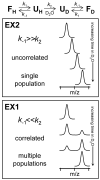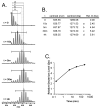Investigating solution-phase protein structure and dynamics by hydrogen exchange mass spectrometry
- PMID: 19937720
- PMCID: PMC2844867
- DOI: 10.1002/0471140864.ps1706s58
Investigating solution-phase protein structure and dynamics by hydrogen exchange mass spectrometry
Abstract
By taking advantage of labeling methods such as hydrogen exchange (HX), many details about protein conformation, dynamics, and interactions can be revealed by mass spectrometry. In this unit, hydrogen exchange theory is discussed as it applies to HX-MS protocols, the practice of HX-MS including data analysis and interpretation is explained in detail, and recent advancements in technology which greatly increase the depth of information gained from the technique are highlighted.
Figures








Similar articles
-
Probing protein structure and dynamics by hydrogen exchange-mass spectrometry.Curr Protoc Protein Sci. 2002 Aug;Chapter 17:17.6.1-17.6.18. doi: 10.1002/0471140864.ps1706s28. Curr Protoc Protein Sci. 2002. PMID: 18429224
-
H/D exchange and mass spectrometry in the studies of protein conformation and dynamics: is there a need for a top-down approach?Anal Chem. 2009 Oct 1;81(19):7892-9. doi: 10.1021/ac901366n. Anal Chem. 2009. PMID: 19694441 Free PMC article.
-
Analysis of protein conformation and dynamics by hydrogen/deuterium exchange MS.Anal Chem. 2009 Oct 1;81(19):7870-5. doi: 10.1021/ac901154s. Anal Chem. 2009. PMID: 19788312 Free PMC article.
-
Hydrogen-exchange mass spectrometry for the study of intrinsic disorder in proteins.Biochim Biophys Acta. 2013 Jun;1834(6):1202-9. doi: 10.1016/j.bbapap.2012.10.009. Epub 2012 Oct 22. Biochim Biophys Acta. 2013. PMID: 23099262 Free PMC article. Review.
-
Protein dynamics and conformational changes explored by hydrogen/deuterium exchange mass spectrometry.Curr Opin Struct Biol. 2019 Oct;58:305-313. doi: 10.1016/j.sbi.2019.06.007. Epub 2019 Jul 25. Curr Opin Struct Biol. 2019. PMID: 31351767 Review.
Cited by
-
Conformational analysis of recombinant monoclonal antibodies with hydrogen/deuterium exchange mass spectrometry.Methods Mol Biol. 2013;988:269-89. doi: 10.1007/978-1-62703-327-5_17. Methods Mol Biol. 2013. PMID: 23475726 Free PMC article.
-
HDX-MS reveals orthosteric and allosteric changes in apolipoprotein-D structural dynamics upon binding of progesterone.Protein Sci. 2019 Feb;28(2):365-374. doi: 10.1002/pro.3534. Epub 2018 Dec 20. Protein Sci. 2019. PMID: 30353968 Free PMC article.
-
Conformational dynamics of the human serotonin transporter during substrate and drug binding.Nat Commun. 2019 Apr 11;10(1):1687. doi: 10.1038/s41467-019-09675-z. Nat Commun. 2019. PMID: 30976000 Free PMC article.
-
Assessment of differences in the conformational flexibility of hepatitis B virus core-antigen and e-antigen by hydrogen deuterium exchange-mass spectrometry.Protein Sci. 2014 Jul;23(7):884-96. doi: 10.1002/pro.2470. Epub 2014 Apr 17. Protein Sci. 2014. PMID: 24715628 Free PMC article.
-
Calcium-induced structural rearrangements release autoinhibition in the Rap-GEF CalDAG-GEFI.J Biol Chem. 2018 Jun 1;293(22):8521-8529. doi: 10.1074/jbc.RA118.002712. Epub 2018 Apr 5. J Biol Chem. 2018. PMID: 29622678 Free PMC article.
References
-
- Bai Y, Milne JS, Mayne L, Englander SW. Protein stability parameters measured by hydrogen exchange. Proteins. 1994;20(1):4–14. - PubMed
-
- Bohak Z. Purification and characterization of chicken pepsinogen and chicken pepsin. J Biol Chem. 1969;244(17):4638–4648. - PubMed
-
- Brier S, Engen JR. Hydrogen exchange mass spectrometry: Principles and capabilities. In: Chance M, editor. Mass spectrometry analysis for protein-protein interactions and dynamics. New York: Wiley-Blackwell; 2008. pp. 11–43.
Publication types
MeSH terms
Substances
Grants and funding
LinkOut - more resources
Full Text Sources

